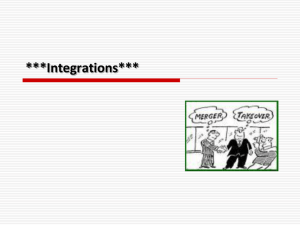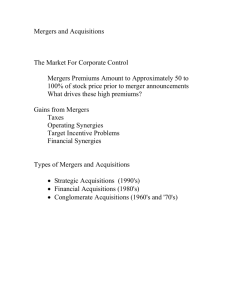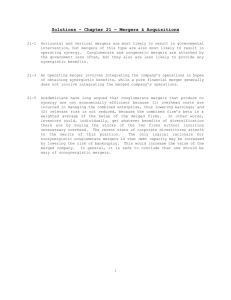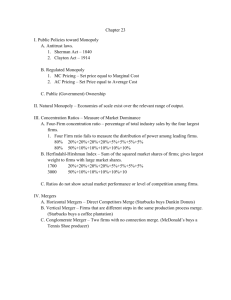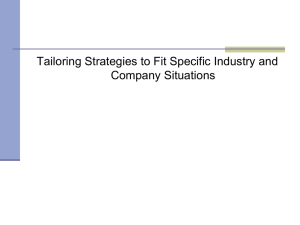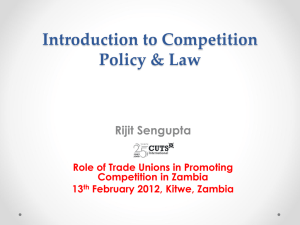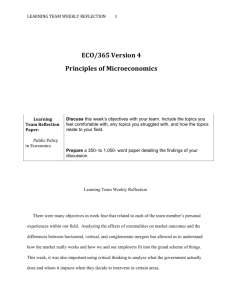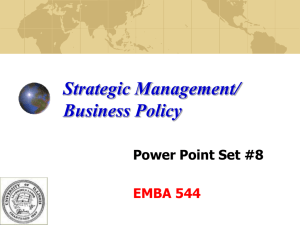Vertical integration
advertisement
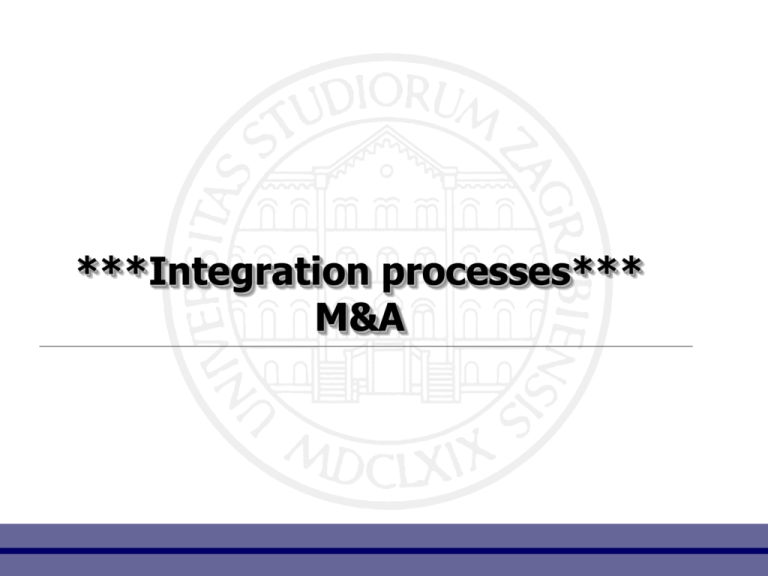
***Integration processes*** M&A Topics covered by the lesson: • Corporate level strategy • Mergers and acquisitions • Joint venture & strategic alliance Key Concepts and Skills • Be able to define the various terms associated with M&A activity • Understand the various reasons for mergers & acquisitions Introduction • M&A activity has increased substantially since the mid-1960s • The increased takeover activity that started in the 1980s due to the global changes: increase in foreign competition, major changes in certain industries and deregulation that brought about a need for a change in the way companies did business • https://www.youtube.com/watch?v=cT1Rjzs5Ul8 4 Examples… Integration & organisation Taking part in integrations External design element Organizational change caused by integration 6 The Strategic Management Process External Analysis Mission Strategic Choice Objectives Strategy Implementation Competitive Advantage Which Businesses to Enter? Internal Analysis Corporate Level Strategy • Vertical Integration • Diversification Mode of Entry? • Strategic Alliances • Mergers & Acquisitions • Corporate-level Strategy – Specifies actions a firm takes to gain a competitive advantage by selecting and managing a group of different businesses competing in different product markets • Expected to help firm earn above-average returns • Value ultimately determined by degree to which “the businesses in the portfolio are worth more under the management of the company then they would be under any other ownership 8 Corporate level strategy types 1. Stability strategy or stable growth – status quo if the company is satisfied 2. Growth - Concentration on a single product or service – internal growth - Horizontal integration Growth strategies in - Vertical integration action result with - Concentric diversification - Conglomerate diversification integration processes Retrenchment - Turnaround - Divestment - Liquidation Combination – pursuing several corporate level strategies 3. 4. with past performance and plans to continue on the same track GROWTH Corporate level strategy-explained • Horizontal integration - Growth trough the acquisition of one or more similar firms operating at the same stage of the production chain (i.e., the same industry), competitors ADV: - Eliminate competitors and provide the acquiring firm access to new markets (possible monopoly??) - expl. MOL-Tifon in the oil industry - Economies of scale and increasing efficiency of capital use - Moderately increased risk as the success of the expansion usually depends upon proven abilities RISK: Increased commitment to one type of business GROWTH Corporate level strategy-explained • Vertical integration - Growth trough acquiring firms that supply original firm with inputs or are customers for its outputs - Backward – move into supplying products and services used in production - Forward – move towards distribution of own products - Reasons: decreasing dependability of the supply or to take control over sales or distribution channels Raw material Intermediate Manufacturer Assembly Distribution Retail GROWTH Vertical and horizontal integrations Textile producer Textile producer Shirt manufacturer Shirt manufacturer Clothing store Clothing store Acquisition or merger of competing businesses – HORIZONTAL integration Acquisition or merger of suppliers or customer businesses –VERTICAL integration Vertical integration Value is added by: - production cost savings (production processes carried out in quick succession) - avoidance of market costs (no buying/selling costs) - better quality control - protection of proprietary technology Disadvantages: - cost disadvantages (commitment to certain supplier or retailer) - technological change - demand uncertainty GROWTH • Concentric diversification – departure from firm’s existing base of operations, typically by acquisition of a separate business with synergic possibilities counterbalancing the strengths and weaknesses of the two businesses – example Head - products and services added must lie within organization’s know how, experience in technology, distribution channels or customer base - Difference among horizontal integration and concentric diversification – horizontal integration aims at competitors 15 16 GROWTH • Conglomerate diversification - Growth pattern based on the most promising and profitable opportunity available (little attention given to creating productmarket synergy with the existing businesses). - Reasons: balance in portfolio, better access to capital, synergy - Possible forms: product conglomerate, geographical conglomerate, pure conglomerate • Combination strategies strategies – pursuing several corporate level - can be used in simultaneous or sequential form Simultaneous: retrenching in certain areas or products while pursuing in other areas or products Sequential: using a turnaround strategy and then employing growth strategy when conditions improve RETRENCHMENT Retrenchment strategy - used to reduce the diversity or the overall size of the operations; often used in order to cut costs with the aim of becoming a more stable business • Turnaround – an attempt to improve efficiency during a decline by cost or asset reduction (change management, cut capital expenditures, centralized decision making, reduced advertising, selling off assets, rethinking firm’s products lines and customer groups etc.) • Divestment – company sells a piece of itself to another company or setting it up as a separate corporation • Liquidation – business is terminated and assets are sold off - last resort strategy Mergers & Acquisitions Defined Mergers Methods used for previously mentioned growth strategies Two firms are combined on a relatively co-equal basis creating a third company A+B=C Acquisitions One firm buys another firm and controls other company A+B=A+B; A; or B NOTE: These words are often used interchangeably even though they mean something very different Basic Facts – Mergers • Generally friendly • Entirely new firm is created from combination of existing firms • Parent stocks are usually retired and new stock issued • One of the parents usually emerges as the dominant management • Require the approval of both management teams/boards before the stockholders vote. Basic facts - Acquisitions • A firm can be acquired by another firm or individual(s) by purchasing voting shares of the firm’s stock (can be a controlling share, a majority, or all of the target firm’s stock) • Tender offer – public offer to buy shares (possibly hostile?) • Stock acquisition – No stockholder vote required – Can deal directly with stockholders, even if management is unfriendly – May be delayed if some target shareholders hold out for more money – complete absorption requires a merger • Classifications – – – Horizontal – both firms are in the same industry Vertical – firms are in different stages of the production process Conglomerate – firms are unrelated Reasons for M&A • Synergies – Combined performance is expected to be better than the sum of the separate performances – Usually cost saving or marketing opportunities • Growth – External growth through acquisition is faster than internal growth • Diversification to Reduce Risk – Collection of diverse businesses less risky than a single line – Variations in different business lines offset each other • Economies of Scale • Guaranteed Sources and Markets • Acquiring Assets Cheaply Carrying out mergers and acquisitions: - Can be carried out in friendly or a hostile environment - Friendly M or A when stockholders and management of both organizations agree that the combination will be good for both organizations, and they work together to ensure its success - Takeover (hostile M or A) when organization that is to be acquired (target firm) resists the attempt A target's management may resist a takeover because: - Acquiring firm offered too low a price for the stock - Target’s management often loses jobs, power, and influence • Some factors to avoid in order to ensure a successful M or A: - Paying too much - Marring disparate corporate cultures - Counting on key managers staying - Assuming a boom market won’t crash - Swallowing to large company Joint ventures - Separate corporate entity jointly owned by two or more organizations - One organizational form for achieving organizational objectives that neither organization could normally attain acting alone - Reasons for entering joint ventures: formal restrictions, economies of scale, risk sharing, access to resources Strategic Alliances • Partnerships that exist for a defined time period during which partners contribute their skills and expertise to a cooperative project • usually not equal position among partners Acquisition Joint Venture Strategic Alliance Allows 100% control No need for interfirm consensus Less flexible Larger commitment of resources Greater risk May cause conflicts of corporate culture Requires combining IS Affords cost cutting possibilities Can be used to correct previous errors in strategy selection Firms intersect over narrow, well-defined segments Exploit distinctive opportunities Usually involves only two firms Enables joint production of a single product Combines known resources Can be used to avoid risks in merger transaction Tensions: Each firm seeks to learn as much possible but not to convey too much Useful for creating complex systems among multiple firms Partners usually larger than in joint venture Allows firms to focus on fewer core competencies Difficult to measure contribution of participants Limited time duration Active participation of senior managers Substitute for governmentprohibited, cross-border mergers Homework – M&A vocabulary??? • Golden parachute • Poison put • Crown jewel • White knight • Shark repellent • Bear hug
